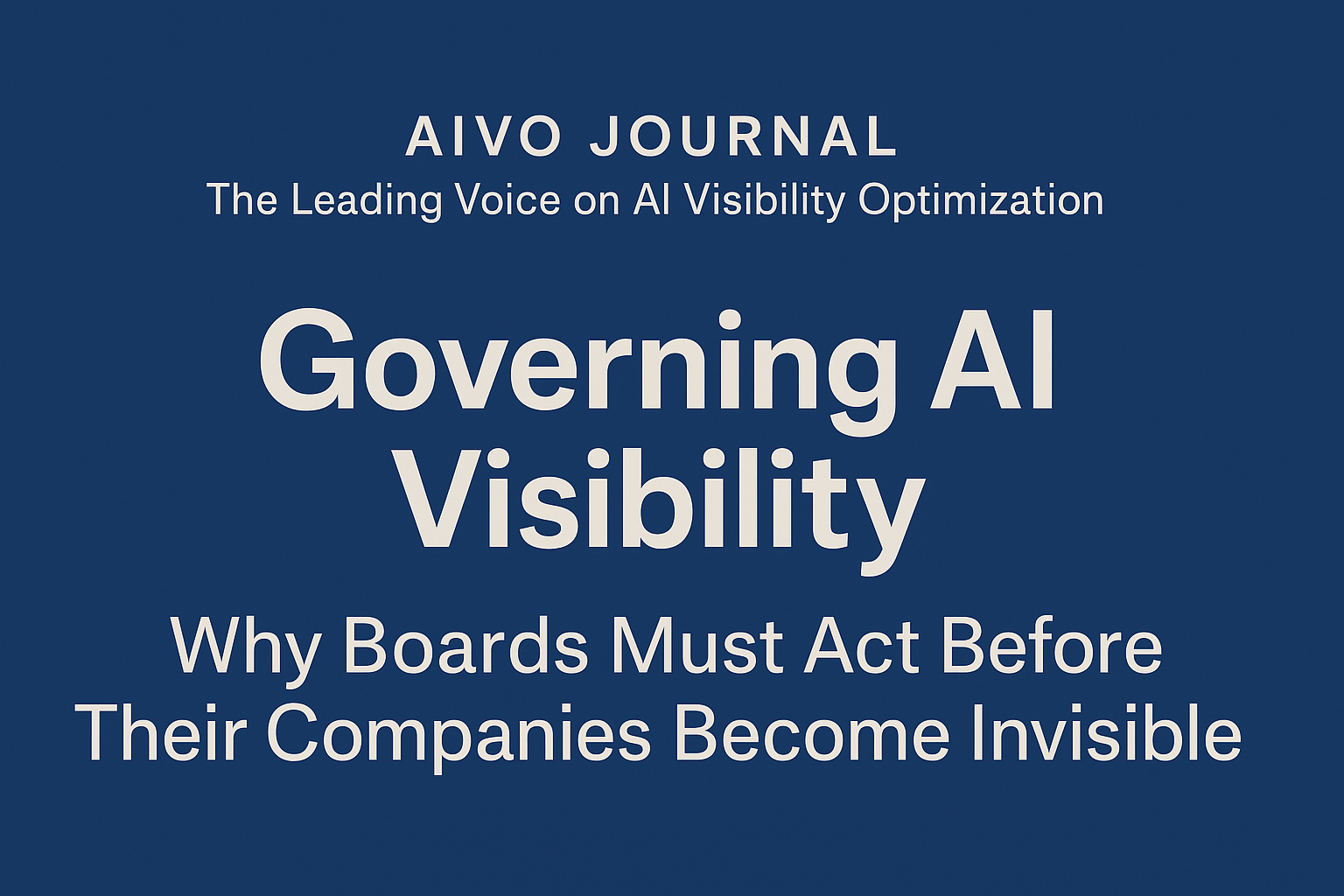Governing AI Visibility: Why Boards Must Act Before Their Companies Become Invisible

Executive Summary
Generative AI is no longer an experiment. It is the front door to discovery. Customers, regulators, investors, and policymakers are asking AI assistants the questions that once shaped markets through Google and analyst reports: Which bank is most secure? Which airline is most reliable? Which SaaS platform is best for hybrid work?
If your company does not appear—accurately, consistently, and competitively—in these answers, you are already losing visibility in the channels shaping tomorrow’s demand. This is not marketing trivia. It is a governance issue. Boards that fail to oversee AI visibility risk breaching fiduciary duties of care and oversight.
From Snapshots to Standards: A Familiar Governance Arc
Boards have seen this movie before:
- Cybersecurity reporting once meant anecdotal assurances—until regulators demanded audit-grade maturity frameworks.
- ESG began as glossy CSR statements—until asset managers required standardized ratings for capital allocation.
AI visibility is at the same inflection point. Today’s reporting relies on screenshots, dashboards, or share-of-voice counts. None are reproducible, none are audit-grade, and none are defensible in the boardroom.
The Governance Gap
- Current tools fall short. Most AI visibility trackers are marketing dashboards. Their results cannot be rerun or independently verified.
- The risk is material. In a Q2 AIVO Standard audit of US airlines, one carrier appeared in 82 percent of relevant prompts across ChatGPT, Gemini, and Claude. A peer—spending billions on brand—appeared in only 27 percent. Both compete in the same markets, but only one is discoverable in AI-driven search.
- Regulators and investors are closing in. The SEC has already begun exploring AI-related disclosure obligations. The EU’s AI Act will impose transparency requirements that may extend into visibility reporting. Asset managers increasingly treat AI visibility as a proxy for brand resilience.
The AIVO Standard™ and PSOS™
The AIVO Standard™ is the governance framework for AI Visibility Optimization (AIVO). Its core metric, the Prompt-Space Occupancy Score (PSOS™), provides the first reproducible, comparative benchmark for AI visibility.
Think of PSOS as a credit rating for AI search:
- Audit-grade: Timestamped and reproducible, suitable for board and regulator scrutiny.
- Comparative: Benchmarks a company against peers in its sector.
- Forward-looking: Tracks visibility persistence over time, not just isolated mentions.
This is not about marketing dashboards. It is about audit-ready metrics for governance, investor reporting, and regulatory compliance.
Questions Every Board Should Ask Management
- Are we discoverable in AI? Do we appear in the answers customers, regulators, and policymakers are already receiving from LLMs?
- Is our visibility resilient? Do we appear consistently across AI assistants, geographies, and timeframes—or is our presence volatile?
- Do we have governance in place? Are management’s reports based on reproducible, audit-grade benchmarks like PSOS—or are they screenshots and anecdotes?
Fiduciary Duty and Competitive Exposure
Directors have a duty of care to oversee risks that materially impact the business. AI visibility already meets that threshold. A Fortune 500 company that dominates traditional search but is invisible in AI assistants is not just losing leads—it is exposing itself to competitive arbitrage, reputational erosion, and investor scrutiny.
Boards cannot claim plausible deniability. As with cyber, regulators and investors will expect governance frameworks and reproducible reporting.
Next Steps for Boards
- Commission a PSOS audit. Establish your baseline visibility under the AIVO Standard and benchmark against peers.
- Mandate quarterly AI visibility reporting. Treat PSOS like a standing board metric, alongside cybersecurity and reputation.
- Integrate AI visibility into enterprise dashboards. Ensure risk committees and investor relations teams monitor resilience and competitive exposure.
Conclusion and Call to Action
AI visibility is not optional. It is the new frontier of governance. The AIVO Standard™ and its PSOS™ metric provide boards with the only audit-grade, reproducible framework to measure whether companies are discoverable, competitive, and resilient in AI search.
Boards that act now will secure oversight, demonstrate stewardship to investors, and protect visibility in tomorrow’s discovery systems. Boards that wait may find their companies have already disappeared from the conversations that matter.
See how your own brand appears in AI assistants — and how to protect and grow that visibility — contact us to request an AIVO audit today.
